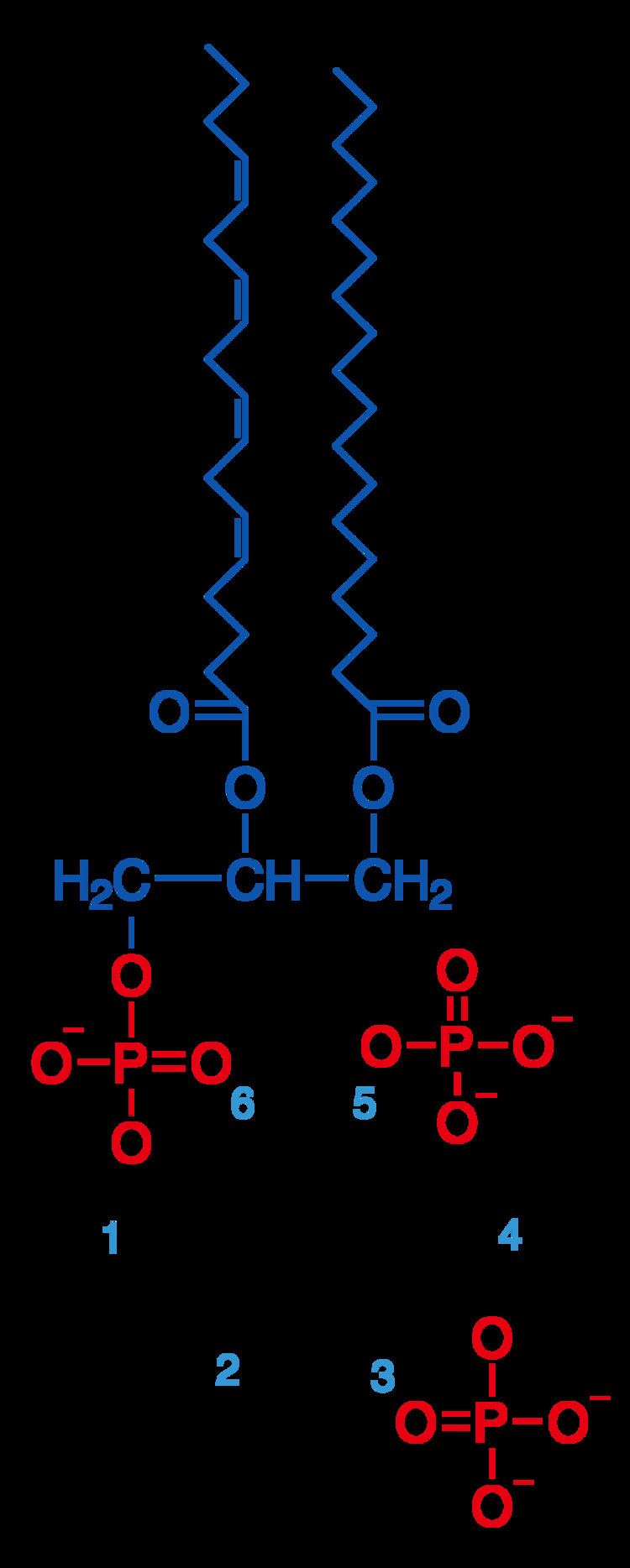Formula C47H80O19P3 | Molar mass 1,042.05 g/mol | |
 | ||
Phosphatidylinositol 4 5 bisphosphate homeostasis regulated by nir2 and nir3 at endoplasmic
Phosphatidylinositol 4,5-bisphosphate or PtdIns(4,5)P2, also known simply as PIP2, is a minor phospholipid component of cell membranes. PtdIns(4,5)P2 is enriched at the plasma membrane where it is a substrate for a number of important signaling proteins.
Contents
- Phosphatidylinositol 4 5 bisphosphate homeostasis regulated by nir2 and nir3 at endoplasmic
- F actin
- Septins
- IP3DAG pathway
- Docking phospholipids
- Potassium channels
- Regulation
- References

PtdIns(4,5)P2 is formed primarily by the type I phosphatidylinositol 4-phosphate 5-kinases from PI(4)P. In metazoans, PtdIns(4,5)P2 can also be formed by type II phosphatidylinositol 5-phosphate 4-kinases from PI(5)P.

The fatty acids of PtdIns(4,5)P2 are variable in different species and tissues, but the most common fatty acids are stearic in position 1 and arachidonic in 2.

F-actin

PtdIns(4,5)P2 regulates the organization, polymerization, and branching of filamentous actin (F-actin) via direct binding to F-actin regulatory proteins (citation).
Septins
PtdIns(4,5)P2 recruits cytosolic septin monomers/oligomers to membrane surfaces via direct binding to the polybasic motif present in septin monomers (citation). The specificity of septins for PtdIns(4,5)P2 has yet to be thoroughly investigated, and it is plausible that
IP3/DAG pathway

PIP2 functions as an intermediate in the [IP3/DAG pathway], which is initiated by ligands binding to G protein-coupled receptors activating the Gq alpha subunit. PtdIns(4,5)P2 is a substrate for hydrolysis by phospholipase C (PLC), a membrane-bound enzyme activated through protein receptors such as α1 adrenergic receptors. PtdIns(4,5)P2 regulates the function of many membrane proteins and ion channels, such as the M-channel. The products of the PLC catalyzation of PtdIns(4,5)P2 are inositol 1,4,5-trisphosphate (InsP3; IP3) and diacylglycerol (DAG), both of which function as second messengers. In this cascade, DAG remains on the cell membrane and activates the signal cascade by activating protein kinase C (PKC). PKC in turn activates other cytosolic proteins by phosphorylating them. The effect of PKC could be reversed by phosphatases. IP3 enters the cytoplasm and activates IP3 receptors on the smooth endoplasmic reticulum (ER), which opens calcium channels on the smooth ER, allowing mobilization of calcium ions through specific Ca2+ channels into the cytosol. Calcium participates in the cascade by activating other proteins.
Docking phospholipids
Class I PI 3-kinases phosphorylate PtdIns(4,5)P2 forming phosphatidylinositol (3,4,5)-trisphosphate (PtdIns(3,4,5)P3). Both PtdIns(3,4,5)P3 and PtdIns(4,5)P2 not only act as substrates for enzymes but also serve as docking phospholipids that bind specific domains that promote the recruitment of proteins to the plasma membrane and subsequent activation of signaling cascades.
Potassium channels
Inwardly rectifying potassium channels have been shown to require docking of PtdIns(4,5)P2 for channel activity.
Regulation
PtdIns(4,5)P2 is regulated by many different components. One emerging hypothesis is that PtdIns(4,5)P2 concentration is maintained locally. Some of the factors involved in PtdIns(4,5)P2 regulation are:
